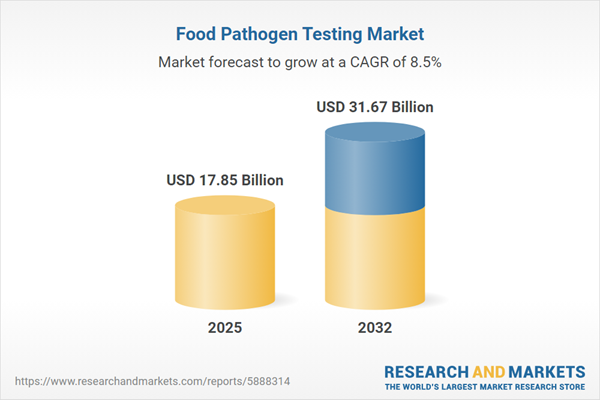Speak directly to the analyst to clarify any post sales queries you may have.
The food pathogen testing market is evolving rapidly, shaped by regulatory demands, technological advances, and shifting consumer expectations. Senior leaders seeking to protect brands and streamline safety protocols will find actionable insights in this report on optimizing detection strategies in a competitive global landscape.
Market Snapshot: Food Pathogen Testing Market Growth & Drivers
The food pathogen testing market grew from USD 16.47 billion in 2024 to USD 17.85 billion in 2025 and is projected to reach USD 31.67 billion by 2032, sustaining a CAGR of 8.51%. This momentum is fueled by stricter regulatory frameworks, supply chain complexity, and advancements in rapid detection and molecular diagnostics. Food producers, contract labs, and regulatory agencies are all prioritizing robust pathogen screening practices, supported by both legacy and state-of-the-art testing methods.
Scope & Segmentation of the Food Pathogen Testing Market
This study provides a detailed breakdown of the market, spotlighting critical areas of growth, innovation, and implementation.
- Product Types: Culture methods, immunoassays, PCR tests, sequencing technologies
- Culture Methods: Enrichment culture, plate culture
- Immunoassays: Enzyme-linked immunosorbent assay, lateral flow
- PCR Tests: Qualitative PCR, quantitative PCR
- Sequencing: Next generation sequencing, Sanger sequencing
- Sample Types: Dairy (cheese, milk, yogurt), fruits and vegetables (fruits, leafy greens), meat and poultry (beef, pork, poultry), processed foods (frozen, ready to eat), seafood (fish, shellfish)
- Pathogen Types: Campylobacter (jejuni), Escherichia coli (O157:H7), Listeria (monocytogenes), Salmonella (enterica serovar Typhimurium)
- Methodologies: Conventional (culture, microscopy) and rapid methods (biosensors, immunoassay, polymerase chain reaction)
- End Users: Contract testing laboratories, food manufacturers (large and small), regulatory agencies, research institutes
- Distribution Channels: Direct sales, distribution partners
- Geographic Regions: Americas (North America, Latin America), Europe, Middle East & Africa, Asia-Pacific—including regional and country-specific coverage
- Leading Companies: Thermo Fisher Scientific Inc., Merck KGaA, bioMérieux SA, Neogen Corporation, Agilent Technologies, Waters Corporation, QIAGEN N.V., Bio-Rad Laboratories, Charles River Laboratories International, 3M Company
Key Takeaways for Senior Decision-Makers
- Food pathogen testing is increasingly shaped by scientific breakthroughs, which are unlocking new levels of sensitivity and speed across production environments.
- Regulatory harmonization and stricter oversight are driving demand for interoperable testing frameworks that meet compliance requirements globally.
- Portfolio diversification in testing methods remains essential, with legacy enrichment cultures and next-generation molecular platforms both playing key roles.
- Changing consumer preferences and the expansion of processed and minimally processed foods are influencing the assortment of sample types under routine surveillance.
- Strategic partnerships and supply chain investments help mitigate risks linked to evolving trade policies and component sourcing.
- Regional differences matter: Americas lead in rapid assay adoption, EMEA focuses on regulatory integration and traceability, while Asia-Pacific emphasizes portability and supply chain transparency.
Tariff Impact: U.S. Measures Realign Supply Chains
New U.S. tariff measures introduced in 2025 have disrupted supply chains, affecting procurement strategies for reagents and instruments. Businesses are adapting through local sourcing, regional supplier partnerships, and collaborative consortia to offset increased costs and maintain performance. This shift prioritizes operational flexibility and underscores the resilience of well-prepared market participants.
Methodology & Data Sources
The report utilizes a multi-phase methodology, including secondary research, primary interviews with stakeholders, and triangulation of qualitative and quantitative data. Analytical frameworks and expert validation ensure data integrity and relevant, actionable conclusions for the food pathogen testing market.
Why This Report Matters for Senior Leaders
- Gain a holistic view of the food pathogen testing landscape from technology trends to regulatory pressures—critical for future-proofing compliance strategies and business operations.
- Leverage targeted segmentation analysis to optimize investment, align testing portfolios with evolving sample needs, and minimize supply chain disruptions.
- Support risk mitigation and strategic planning with region- and market-specific intelligence, enabling informed executive decisions across global and local operations.
Conclusion
This report delivers in-depth analysis and actionable insights for organizations navigating the changing food pathogen testing sector. Leaders can leverage these findings to drive sustainable growth, ensure robust food safety protocols, and stay ahead in a dynamic regulatory environment.
Additional Product Information:
- Purchase of this report includes 1 year online access with quarterly updates.
- This report can be updated on request. Please contact our Customer Experience team using the Ask a Question widget on our website.
Table of Contents
3. Executive Summary
4. Market Overview
7. Cumulative Impact of Artificial Intelligence 2025
Companies Mentioned
The companies profiled in this Food Pathogen Testing market report include:- Thermo Fisher Scientific Inc.
- Merck KGaA
- bioMérieux SA
- Neogen Corporation
- Agilent Technologies, Inc.
- Waters Corporation
- QIAGEN N.V.
- Bio-Rad Laboratories, Inc.
- Charles River Laboratories International, Inc.
- 3M Company
Table Information
| Report Attribute | Details |
|---|---|
| No. of Pages | 187 |
| Published | October 2025 |
| Forecast Period | 2025 - 2032 |
| Estimated Market Value ( USD | $ 17.85 Billion |
| Forecasted Market Value ( USD | $ 31.67 Billion |
| Compound Annual Growth Rate | 8.5% |
| Regions Covered | Global |
| No. of Companies Mentioned | 11 |









